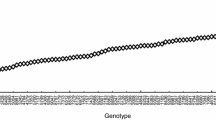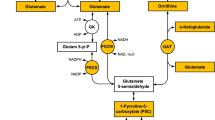Abstract
We evaluated Al-tolerance in 44 interspecific lines (32 upland and 12 lowland) developed from the crosses of Oryza sativa and O. glaberrima called New Rice for Africa (NERICA) with 2 O. glaberrima lines and 13 O. sativa varieties under hydroponic culture containing 0.15, 0.3, 0.6, and 1.2 mM Al (+Al) and 0 mM Al (−Al as a control). Ten upland and four lowland NERICA lines showed strong Al-tolerance judging from their higher relative root and shoot dry weights (percentage ratios of dry weights in the Al treatments to the control) than those of the tolerant O. sativa check of IR 53650. Their tolerance was supported by relatively higher root Al accumulation (dark blue color) opposite performance with common knowledge (shown pale blue color) in root using hematoxylin staining compared to the Al-susceptible genotypes identified based on relative root and shoot dry weights in the study. Net Al concentration was higher in roots than in shoots in all +Al conditions for all genotypes; however, a clear difference in the Al concentration among the Al-tolerant, Al-moderately tolerant, and Al-susceptible genotypes was observed in the shoots. Al concentrations in the shoots of the Al-tolerant and Al-moderately tolerant upland and lowland NERICA lines were significantly lower than those of its Al-susceptible counterparts in the groups under 0.6 and 1.2 mM Al conditions, respectively. Differences in root and shoot growth among the Al-tolerant, Al-moderately tolerant, and Al-susceptible NERICA lines were clearer under strong Al toxic conditions (0.6 and 1.2 mM Al) than under weak Al toxic conditions (0.15 and 0.3 mM Al).
Similar content being viewed by others
Abbreviations
- NERICA:
-
New rice for Africa
- RRDW:
-
relative root dry weight
- RSDW:
-
relative shoot dry weight
References
Baggie I, Zapata F, Sanginga N. 2002. Genotypic response to aluminum toxicity of some rice. Int. Rice Res. Notes 27: 42
Cançado GMA, Loguercio LL, Martins PR, Parentoni SN, Paiva E, Borém A, Lopes MA. 1999. Hematoxylin staining as a phenotypic index for aluminum tolerance selection in tropical maize (Zea mays L.). Theor. Appl. Genet. 99: 747–754
Chen RF, Shen RF. 2008. Root phosphate exudation and pH shift in the rhizosphere are not responsible for aluminum resistance in rice. Acta Physiol. Plant. 30: 817–824
Foy CD. 1992. Soil chemical factors limiting plant root growth. Adv. Soil Sci. 19: 97–149
Foy CD, Chaney RL, White MC. 1978. The physiology of metal toxicity in plants. Ann. Rev. Plant Physiol. 29: 511–566.
Jones MP, Dingkuhn M, Aluko GK, Semon M. 1997. Interspecific Oryza sativa L. x O. glaberrima Steud. proge nies in upland rice improvement. Euphytica 92: 237–246
Kang DJ, Ishii R. 2003. Studies on acid soil tolerance of rice plants (Oryza sativa L.) I. Morphological and physiological characteristics of acid soil tolerant varieties of rice plants. Jpn. J. Crop Sci. 72: 171–176 (Japanese text with English summary)
Kang DJ, Ishii R. 2006. Formation of organic acids in the root apices of rice plants (Oryza sativa L.) grown in acidic nutrient solution containing aluminum. Plant Prod. Sci. 9: 228–231
Kang DJ, Seo YJ, Lee BK, Vijarnson P, Ishii R. 2010. Identified and crop performance of acid sulfate soil-tolerant rice varieties. J. Crop Sci. Biotech. 13: 75–81
Ownby JD. 1993. Mechanisms of reaction of hematoxylin with aluminium treated wheat roots. Physiol. Plant. 87: 371–380
Polle E, Konzak CF, Kattrick JA. 1978. Visual detection of aluminum tolerance levels in wheat by hematoxylin staining of seedling roots. Crop Sci. 18: 823–827
Powell D, Kelly R, Yang G, Kamp-Glass M. 1996. Rapid prediction of aluminum tolerance in alfalfa. Hort. Sci. 31: 755
Rincón M, Gonzales RA. 1992. Aluminum partitioning in intact roots of aluminum-tolerant and aluminum-sensitive wheat (Triticum aestivum L.) cultivars. Plant Physiol. 99: 1021–1028
Sahrawat KL, Sika M. 2002. Comparative tolerance of Oryza sativa and O. glaberrima rice cultivars for iron toxicity in West Africa. Int. Rice Res. Notes 27: 30–31
Sharma P, Dubey RS. 2007. Involvement of oxidative stress and role of antioxidative defense system in growing rice seedlings exposed to toxic concentration of aluminum. Plant Cell Rep. 26: 2027–2038
Tamas L, Budikova S, Simonovicova M, Huttova J, Siroka B, Mistrik I. 2006. Rapid and simple method for Al-toxicity analysis in emerging barley roots during germination. Biol. Plant. 50: 87–93
Tobita S, Sahrawat KL, Diatta S, Jones MP. 2003. Response of African rice (Oryza glaberrima Steud.) to phosphate application in the upland of a P-deficient soil in the humid forest zone of West Africa. In Proc. 2nd Intl. Sym. Phosphorus Dynamics Soil-Plant Continuum, Perth, Western Australia, Australia, 21–26 September 2003, pp. 70–71
Vázquez MD, Poschenrieder C, Corrales I, Barceló J. 1999. Change in apoplastic aluminum during the initial growth response to aluminum by roots of a tolerant maize variety. Plant Physiol. 119: 435–444
Wagatsuma T, Khan MSH, Rao IM, Wenzl P, Tawaraya K, Yamamoto T, Kawamura T, Hosogoe K, Ishikawa S. 2005. Methylene blue stainability of root-tip protoplasts as an indicator of aluminum tolerance in a wide range of plant species, cultivars and lines. Soil Sci. Plant Nutr. 51: 991–998
Yang JL, Li YY, Zhang YJ, Zhang SS, Wu YR, Wu P, Zheng SJ. 2008. Cell wall polysaccharides are specifically involved in the exclusion of aluminum from the rice root apex. Plant Physiol. 146: 602–611
Yoshida S, Forno DA, Cock JH, Gomez KA. 1976. Routine procedure for growing rice plants in culture solution. Laboratory manual for physiological studies of rice, Ed 3, The International Rice Research Institute, Los Banos, Laguna, Philippines, pp. 61–65
Author information
Authors and Affiliations
Corresponding author
Rights and permissions
About this article
Cite this article
Kang, DJ., Futakuchi, K., Seo, YJ. et al. Evaluation of Al-tolerance on upland and lowland types of NERICA lines under hydroponic conditions. J. Crop Sci. Biotechnol. 15, 25–31 (2012). https://doi.org/10.1007/s12892-011-0083-6
Received:
Revised:
Accepted:
Published:
Issue Date:
DOI: https://doi.org/10.1007/s12892-011-0083-6




